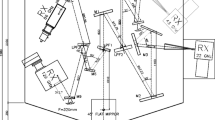Abstract
Millimeter-wave (mmW) imaging has evolved to the point where it offers distinctive remote sensing capabilities in many application scenarios, such as port and harbor security, search and rescue, and navigational aids, due to its unique ability to penetrate atmospheric obscurants. Some of the applications being considered require passive imaging, imposing challenging sensitivity requirements to detect the low power levels in this spectral region. One metric used in this regard is the noise equivalent power (NEP), which quantifies the sensitivity of a detector. By utilizing a unique detector technology based on optical upconversion a low NEP value is achieved as compared to other RF methods, without the use of cryogenic cooling or low noise amplification. In addition, the overall size and weight may be reduced as compared to other imaging methodologies. As such, the construction and development of a passive mmW imaging system utilizing optical upconversion was undertaken, operating in the Q-Band to collect radiation between 33 and 50 GHz. Herein, we describe the passive mmW imager architecture and operation. Also presented are imaging results obtained using this approach as well as key imager metrics that have been experimentally validated.









Similar content being viewed by others
References
J. Preissner, “The Influence of the Atmosphere on Passive Radiometric Measurements,” AGARD Conference Proc. 245, 48 (1979).
F.T. Ulaby, R.K. Moore, A.K. Fung, Microwave Remote Sensing: Active and Passive, vol. 1, Addison-Wesley, Reading (1981).
C. A. Schuetz and D. W. Prather, “Optical Upconversion Techniques for High-Sensitivity Millimetre-Wave Detection,” Proc. SPIE 5619, 166 (2004).
C. A. Schuetz, J. Murakowski, G. J. Schneider, and D. W. Prather, “Radiometric Millimeter-Wave Detection via Optical Upconversion and Carrier Suppression,” IEEE T. Microw. Theory, 53(5), 1732–1738 (2005).
E. Desurvire, Erbium-Doped Fiber Amplifiers: Principles and Applications, Wiley, New York (1994).
A. Yariv, Introduction to Optical Electronics, Holt, Rinehart, and Winston, New York (1971).
C. A. Schuetz, Optical Techniques for Millimeter-Wave Detection and Imaging, Doctoral Dissertation, University of Delaware, Newark, DE (2007).
C. A. Schuetz, R. D. Martin, I. Biswas, M. S. Mirotznik, S. Shi, G. J. Schneider, J. Murakowski, and D. W. Prather, “Sparse Aperture Millimeter-Wave Imaging Using Optical Detection and Correlation Techniques,” Proc. SPIE 6548, 65480B (2007).
R. Martin, C. A. Schuetz, T. E. Dillon, C. Chen, J. Samluk, E. L. Stein, Jr., M. Mirotznik, and D. W. Prather, “Design and Performance of a Distributed Aperture Millimeter-Wave Imaging System Using Optical Upconversion,” Proc. SPIE 7309, 730908 (2009).
Quinstar Technology, Inc. http://www.quinstar.com/qea_broadband_detectors.html.
E. J. Boettcher, K. Krapels, R. Driggers, J. Garcia, C. Schuetz, J. Samluk, L. Stein, W. Kiser, A. Visnansky, J. Grata, D. Wikner, and R. Harris, “Modeling Passive Millimeter Wave Imaging Sensor Performance for Discriminating Small Watercraft,” Appl. Opt. 49(19), E58-E66 (2010).
K. Krapels, R. G. Driggers, J. Garcia, E. Boettcher, D. Prather, C. Schuetz, J. Samluk, L. Stein, W. Kiser, A. Visnansky, J. Grata, D. Wikner, and R. Harris, “Millimeter Wave Sensor Requirements for Maritime Small Craft Identification,” Proc. SPIE 7485, 74850H (2009).
M. R. Fetterman, J. Grata, G. Jubic, W. L. Kiser, and A. Visnansky, “Simulation, Acquisition and Analysis of Passive Millimeter-Wave Images in Remote Sensing Applications,” Opt. Express, 16(25), 20503–20515 (2008).
D. A. Wikner and G. Samples, “Polarimetric Passive Millimeter-Wave Sensing,” Proc. SPIE 4373, 86 (2001).
J. P. Samluk, Millimeter Wave Far-Field Imaging via Optical Upconversion Techniques, Masters Thesis, University of Delaware, Newark, DE (2008).
J. P. Samluk, C. A. Schuetz, E. L. Stein, Jr., A. Robbins, D. G. Mackrides, R. D. Martin, C. Chen, and D. W. Prather, “Far Field Millimeter-Wave Imaging via Optical Upconversion,” Proc. SPIE 6948, 694804 (2008).
G. D. Boreman, Modulation Transfer Function in Optical and Electro-Optical Systems, SPIE, Bellingham (2001).
E. L. Stein, Jr., C. A. Schuetz, and D. W. Prather, “Development of a Robust Digital Lock-In Algorithm Using a Closed Form Least Squares Method,” Proc. SPIE 7348, 734807 (2009).
Acknowledgements
The author wishes to thank the Office of Naval Research for their support of this research under grant number N00014-04-1-0616, and the Defense Advanced Research Projects Agency Microsystems Technology Office.
Author information
Authors and Affiliations
Corresponding author
Rights and permissions
About this article
Cite this article
Samluk, J.P., Schuetz, C.A., Dillon, T. et al. Q-Band Millimeter Wave Imaging in the Far-Field Enabled by Optical Upconversion Methodology. J Infrared Milli Terahz Waves 33, 54–66 (2012). https://doi.org/10.1007/s10762-011-9850-1
Received:
Accepted:
Published:
Issue Date:
DOI: https://doi.org/10.1007/s10762-011-9850-1




